Memo From Turner
Didn’t I see you down in San Antone on a hot and dusty night
Weren’t you eating eggs in Sammy’s there when the black man drew the knife
Didn’t you drown the Jew in Rampton when he washed his sleeveless shirt
With a Spanish speaking gentleman, the one that we call Kirk
Come now, gentlemen, there must be some mistake
How forgetful I’m becoming now, you fixed your business straight
Weren’t you at the Convacoby back in 1956
You’re a faggot, little leather boy with a smaller piece of stick
You’re a lashing, smashing hunk of man, your sweat shines sweet and strong
Your organ’s working perfectly but there’s a part that’s screwed on wrong ( Jagger/Richards)
”The reasons for both the sanctification and the denunciation were more or less the same: Turner’s preference for poetic atmospherics over narrative clarity, his infatuation with the operation of light rather than with the objects it illuminated. His love affair with gauzy obscurity, his resistance to customary definitions of contour and line, his shameless rejoicing in the mucky density of oils or in the wayward leaks and bleeds of watercolors—these were condemned as reprehensible self-indulgence. Sir George Beaumont, collector, patron, and, as he supposed, arbiter of British taste, complained noisily of Turner’s “vicious practice” and dismissed his handling of the paint surface as “comparatively, blots.” The caustic essayist William Hazlitt was especially troubled by Turner’s relish of visual ambiguity: the sharp line melting into the swimming ether. Contrary to Ruskin, Hazlitt thought it was unseemly for Turner to fancy himself playing God, reprising the primordial flux of Creation. Someone, Hazlitt commented, had said that his landscapes “were pictures of nothing and very like.’ ” ( clevermynnie.livejournal.com)
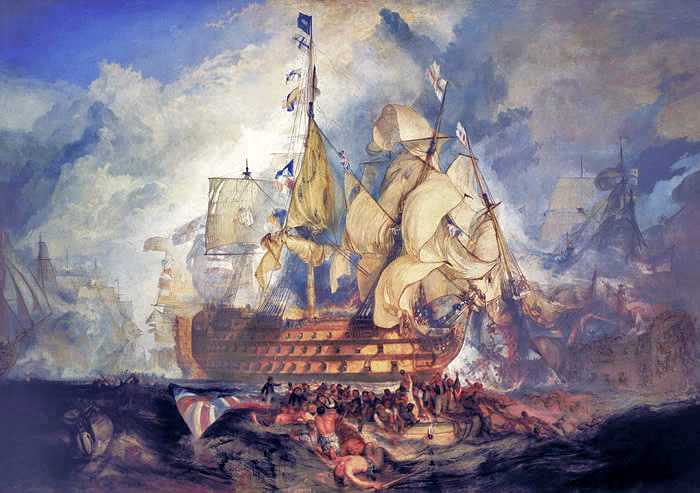
Simon Schama: ''In the case of the spectacular action painting "The Battle of Trafalgar," Turner did his homework, going to Sheerness to see the hulk of Nelson's flagship, H.M.S. Victory, and carefully sketching its splintered beams. But he threw the research away to compose, in 1806, an astounding enactment of the chaos of war at sea, using a viewpoint high up in the mizzenmast shrouds, where, although ostensibly on the British man-of-war, the beholder can as easily imagine himself in the roost of the French sharpshooter who kills Nelson. The entanglement of the ships of the line, like so many lumbering dinosaurs locked in belligerent slaughter, is described through an inchoate massing of sails, each impossible to connect to any vessel in particular. It's a maritime traffic jam, a smoke-choked pileup with nowhere to go, no visible stretch of sea! And, in case people weren't already confused, Turner made matters worse by collapsing two discrete consecutive episodes into one: the French surrender, indicated by the tricolor laid on the deck of Nelson's flagship, and the canonical climax of Trafalgar, Nelson dying, stretched out amid the huddle of his grieving officers. Victory's victory becomes Pyrrhic, the tragedy embittering the triumph. ''
Memo from Turner. He’s smart, but he’s no Turner. You mean Einstein? A genius is a person, a body of work, or a singular achievement of surpassing excellence. More than just originality, creativity, or intelligence, genius is associated with achievement of insight which has transformational power.If Mozart had a genius for music, and Moses a genius for wandering around a dessert;then Turner had a genius for painting. Genius is one of the oldest and yet one of the most elusive concepts in the history of psychology, and also one of the most fascinating. Originally, in Graeco-Roman antiquity, genius referred to a quality that everyone possessed, an animating spirit that represented one’s character and interests as much as one’s ability. Over time, however, it became increasingly associated with one’s natural ability or talent, and eventually with the special ability of a few. Genius is typically defined as one or both of the following definitions of which Turner fits : Distinguished mental superiority; uncommon intellectual power; especially, superior power of invention or origination of any kind, or of forming new combinations; and/or, A man endowed with uncommon vigor of mind; a man of superior intellectual faculties.
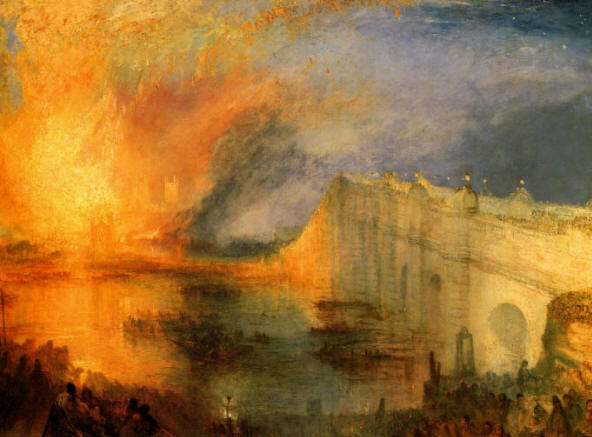
schama: ''When the Houses of Parliament caught fire, on the night of October 16, 1834, Turner, along with a throng of fellow-Londoners, rushed to see the spectacular inferno. Hiring a boat, he bobbed back and forth, riding the tide, at Westminster Bridge. There had been no foul play, but, since a Parliamentary-reform act had been passed just two years before, amid loudly voiced fears that, unless it was legislated, the kingdom might, like France in 1830, go down in bloody revolution, the relationship between rulers and ruled was in perilous play. A dominating feature of the two "Burning of the Houses of Lords and Commons" paintings that resulted—one now in Cleveland and one in Philadelphia—is the crowds jamming the embankment and Westminster Bridge, watching, fixedly, the cremation of "Old Corruption.' ''
Earth, Air, Fire and Water.Four strong winds. Turner was the English genius who united them in paintings that hinted of the chaos of creation. If England has produced a single genius among its many painters of talent, intelligence, and originality, that genius is Joseph Mallord William Turner. Alone among English painters Turner had genius to a degree that is inexplicable and that can only be accepted as an independent phenomenon, self generated and self-sustaining.
”But that is precisely what we do like, do we not? Turner’s art of conjuring something from nothing, and then (unlike God) having the temerity to deposit the working trace of that mysterious process on the canvas, has made him a paragon for modernists. He seems to have understood picturing as a collaborative process between the artist’s hand and the beholder’s eye, in which the former laid down suggestive elements and the imaginative observer assembled them in his mind to make a coherent subject. Sometimes he would help the process along, sometimes not. But he was much taken by the indeterminacy of the exercise, by forms that escaped resolution. The sobriety of the hard edge became, one has to think, a sign of conceptual banality, a weakness in the mind’s eye. For him the purest form, and one that he repeatedly returned to
s also the most naturally unstable: the rainbow. ” ( clevermynnie.livejournal.com)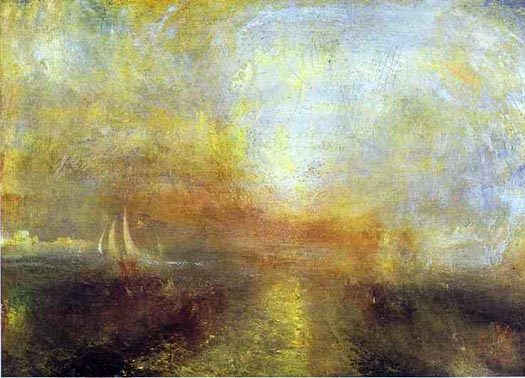
Turner. Yacht Approaching the Coast. One of Turner,s late oil sketches. it was painted for his own enjoyment and was not exhibited in his lifetime. It became admired and sanctified by the followers of modern abstractionism.
The extent of Turner’s originality has ben revealed only gradually by the series of aesthetic revolutions that have transformed our way of looking at art since his death in 1851. His long career carried him from realistic beginnings to an abstract conclusion, which is also the history of modern art. The impressionists were the first painters to discover that Turner had anticipated them; his water colors have been compared to Cezanne’s. The cubists, it must be admitted, have been unable to tie their art to his, but the abstract expressionists and ”action’, painters of the 1950’s claimed him as an ancestor.
An yet, during the second half of the nineteenth century and the first quarter of the twentieth, Turner’s art had very little direct influence on the various painters or schools who seem to be descended from him. He has been discovered after the fact of revolutions rather than as a point of departure. The late sketches in which his originality seems most emphatically declared were not exhibited at all until 1906, and not in any quantity until 1938. After that, Turner’s official canonization had to wait another twenty-eight years until, in 1966, the Museum of Modern Art in New York ( MOMA ) exhibited him, not as a nineteenth-century romantic, which he was, but as a twentieth-century abstractionist, which he can be made to seem by selecting certain bits and pieces of his work and thereby reducing the tremendous field of his art to the dimensions of a mere studio exercise.
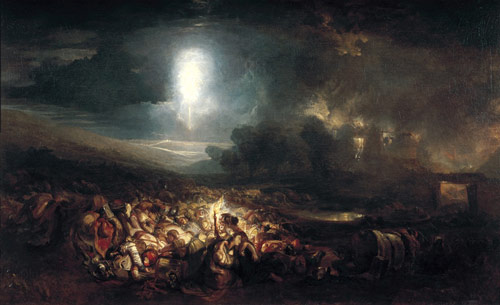
www.metmuseum.org ''The Duke of Wellington fared no better than Nelson. In 1817, Turner, after visiting the site of the bloody victory over Napoleon, at Waterloo, chose instead to paint the harrowing aftermath: a nocturnal carpet of corpses lit by the sulfurous glare of a rocket, with grieving wives and sweethearts, some of them carrying infants, searching desperately through the human debris. It is a return to the distraught Niobes of the Greeks, the wailing woman as personification of calamity. ''
His field was the universe, and in discovering it he reversed, or inverted the Biblical process of creation. He turned it inside out to achieve an explosive force of transformation as if he released a pressurized seal just in time before the container exploded. As a young artist he saw the world as the comfortably inhabited landscape of England, but as an old man he painted it as a spectacle of the four elements. Air, fire and water fuse and spin around a vortex within which all solid forms have dissolved, but which also serve as the primordial womb of force from which the earth was born.
Whatever he understood of theory, or more accurately, whatever he applied, was negligible in the achievement of his ultimate expression. For every passage in his work that seems to conform to a theory there are hundreds that contradict it; he was an empiricist who fulfilled his genius over a long route which he covered inch by experimental inch.
Clean sweeps; tragic cleansing poundings that in their process of extinction would purify and give rebirth. It was his own interpretation of ”eternal recurrence” except the scale was enormous. To know why the universe exists, why there is something greater than nothing would require the painful and agonizing process of returning to the sources even if it meant digging up suppressed and enraged emotions; the dragon that Saint George had bottled up in the middle of the earth was now on the prowl. There was hubris, and ego involved, and the frustration of not providing a compelling answer to humankind’s most difficult question led to the creation of a new artistic transformation where metaphysics would collide with the scientific revolution.
”His approach to war, too, was radically unheroic. The norm for battle pieces was to memorialize the genius of command and the gallantry of the ranks. Turner had tried this, in 1800, with an innocuous version of the battle of Seringapatam, in southern India, where serried lines of scarlet coats advance on the distant citadel of the Sultan of Mysore. But what he really liked, in common with much of the British public, was a good disaster. Around 1805, a series of calamities—the Plagues of Egypt, the destruction of Sodom, shipwrecks, the panic-stricken and the prostrate—begin to populate his large dark, thunderstruck canvases. In all these gloomy efforts, the human figures are limp, almost invertebrate, their faces summarized in a few caricatural strokes and their bodies weirdly attenuated, as if in a new Mannerism. Turner was not, as sometimes charged, an incompetent figure painter. He had spent years in academic drawing and in his early career had produced conventionally modelled studies. But when it came to the big oils he chose to stylize them, as if in self-conscious repudiation of the classical tradition.For Turner, the distortions were the agents of narrative: the representation of the figure as victim, the disarticulated plaything of history’s mischief.”


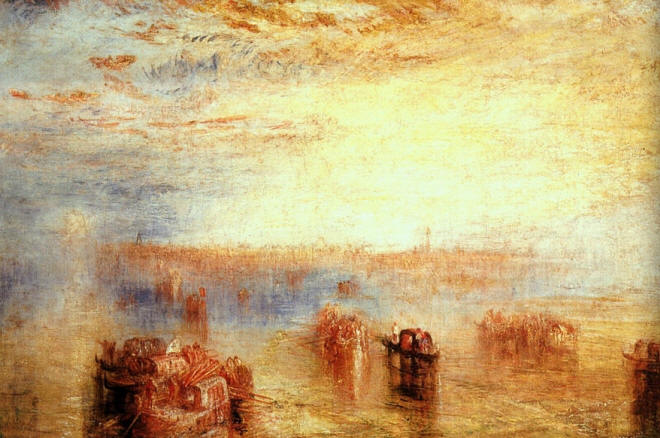



 COMMENTS
COMMENTS